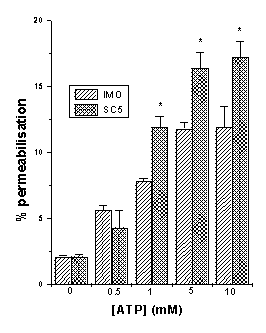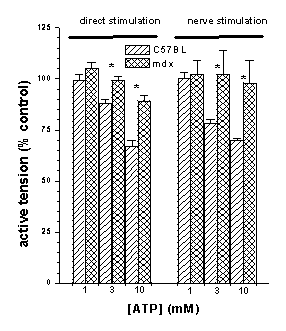| pA2 online © Copyright 2004 The British Pharmacological Society |
108P
University of Newcastle Winter Meeting December 2004 |
Purinergic responses in SC5 and IMO skeletal muscle cell lines and phrenic nerve-diaphragm preparations from C57BL and mdx mice S. Arkle, D. Górecki , M. Idris, H. Lodmüller & D. Yeung. School of Pharmacy & Biomedical Sciences, University of Portsmouth, Portsmouth, PO1 2DT, U.K. |
|
Differences in cellular responses to purinergic stimulation of lymphoblastoid cells cultured from Duchenne muscular dystrophy (DMD) patients as compared to those from individuals without the disease have been reported and may be attributable to altered function of P2X7 receptors (Ferrari et al. 1994). Our own unpublished data indicate differences in P2X7 receptor expression in skeletal muscle obtained from mdx (a model of DMD containing mutation of the dystrophin gene) and C57BL (control) mice. This suggests a relationship between DMD and purinergic receptor function. We have further investigated this by testing the effects of ATP on cellular (cell permeabilisation; a response associated with P2X7-stimulation) and tissue (diaphragm contractility) responses in cell lines derived from mdx mouse muscle and in mdx mouse diaphragms respectively.
Cell permeabilisation was assessed by fluorimetric measurement of propidium iodide (PI) uptake into SC5 (mdx-derived dystrophic cell line) and IMO (non-dystrophic counterpart of SC5) myoblasts maintained in Krebs Henseleit buffer at 37 °C. Muscle contractility was measured in phrenic nerve-diaphragm preparations obtained from four month old, male mice. Standard organ bath techniques were used with recording of isometric tension during alternate 5 min. periods of electrical nerve or muscle stimulation (100V for 0.5msec at 0.1Hz).
ATP stimulated PI uptake in both SC5 and IMO cells but the response was statistically higher in SC5 cells (fig.1). ATP decreased contractility of both directly (muscle)- and indirectly (nerve)-stimulated diaphragms (fig. 2) but produced the more marked effect in the non-dystrophic muscle. Similar effects were observed in both directly- and indirectly-stimulated preparations.


| Fig.1. Effects of ATP on PI uptake in myoblasts (n=4). There were significant effects of cell type and ATP (P<0.05 and P<0.001 respectively, 2 way ANOVA). *: difference in response between SC5 and IMO cells (P<0.05 in post hoc Bonferroni tests). | Fig.2. Effects of ATP on diaphragm contractility (n-5). There were significant effects of mouse strain and ATP for direct stimulation and of strain for nerve stimulation (P<0.001, 2 way ANOVA). *: difference in response between strains (P<0.05 in post hoc Bonferroni tests). |
These data confirm that there are differences in purinergic responses between dystrophic and non-dystrophic cells and extend this observation to muscle-derived cell lines and to the level of tissue function. The dominant effect of ATP in the diaphragm is through a direct action on the muscle rather than via altered neurotransmission.
Ferrari et al., (1994) Am. J. Physiol ., 267: C886-C892.